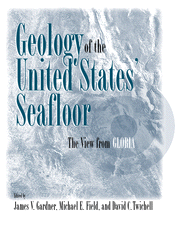Book contents
- Frontmatter
- Contents
- Contributors
- Foreword
- Introduction
- Part I The GLORIA System and Data Processing
- Part II U. S. East Coast EEZ
- Introduction
- 3 The Timing and Spatial Relations of Submarine Canyon Erosion and Mass Movement on the New England Continental Slope and Rise
- 4 Characteristics of the Continental Slope and Rise off North Carolina from GLORIA and Seismic-Reflection Data: The Interaction of Downslope and Contour Current Processes
- Part III Gulf of Mexico and Caribbean EEZ
- Part IV U. S. West Coast EEZ
- Part V Alaskan EEZ
- Index
4 - Characteristics of the Continental Slope and Rise off North Carolina from GLORIA and Seismic-Reflection Data: The Interaction of Downslope and Contour Current Processes
Published online by Cambridge University Press: 25 January 2010
- Frontmatter
- Contents
- Contributors
- Foreword
- Introduction
- Part I The GLORIA System and Data Processing
- Part II U. S. East Coast EEZ
- Introduction
- 3 The Timing and Spatial Relations of Submarine Canyon Erosion and Mass Movement on the New England Continental Slope and Rise
- 4 Characteristics of the Continental Slope and Rise off North Carolina from GLORIA and Seismic-Reflection Data: The Interaction of Downslope and Contour Current Processes
- Part III Gulf of Mexico and Caribbean EEZ
- Part IV U. S. West Coast EEZ
- Part V Alaskan EEZ
- Index
Summary
Introduction
In 1987, the U.S. Geological Survey (USGS) completed fieldwork on a Geologic LOng-Range Inclined Asdic (GLORIA) sidescan sonar survey of the U.S. Atlantic Exclusive Economic Zone (EEZ-SCAN 87 Scientific Staff 1991). The resulting GLORIA mosaic image from this survey covered the continental slope and rise off North Carolina, one of the best-studied and most intensely sampled margins of the world. Although a great number of studies have been conducted in this area, the GLORIA image presented the first truly integrated picture of the North Carolina margin that depicts the interplay of three different styles of slope and rise processes: (1) gravity-controlled processes including canyon, channel, and fan systems; (2) mass wasting processes including slumps, slides, and debris flows; and (3) contour current-controlled processes including the deposition of large sediment drifts and the scouring of large areas of seafloor. This chapter examines the GLORIA sidescan sonar image and the USGS seismic records to review the interplay of these systems in shaping the slope and continental rise of the segment of the margin off North Carolina. It reexamines the major rise features such as the canyons and debris slides and comments on previous studies that have been based on the interpretation of 3.5-kHz echo character.
- Type
- Chapter
- Information
- Geology of the United States' SeafloorThe View from GLORIA, pp. 59 - 80Publisher: Cambridge University PressPrint publication year: 1996
- 1
- Cited by



